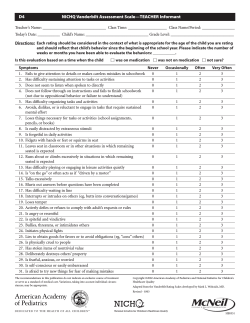
Options for Victorian Agriculture in a “New” Climate
DEPARTMENT OF PRIMARY INDUSTRIES CSIRO ATMOSPHERIC RESEARCH Options for Victorian Agriculture in a “New” Climate -a pilot study linking climate change scenario modelling and land suitability modelling Bob Cechet, Adam Hood & Hemayet Hussain Background • Victorian Greenhouse Strategy Understand climate change impacts and develop adaptation options with sectors/community • Funding - Ecological Sustainable Agriculture Initiative (DPI) - Greenhouse Policy Unit (DSE) Atmospheric Research Land Suitability Framework • Developed by United Nations F.A.O. • Assesses suitability of land for specific use • Assessment undertaken using spatial datasets for various elements based on a function of the interaction between them and/or through a multi-criteria analysis method Atmospheric Research Land Suitability Analysis (LSA) • Developed using ArcView Model Builder • Uses discrete spatial datasets of soil, landscape and climate (within G.I.S. environment) • Based on “expert systems” approach • Easy to scale to regional/strategic levels • Highly flexible (dependent on question being asked) • Simple to manipulate/interrogate Atmospheric Research Project Design Land Suitability Analysis Climate Scenario Tools Commodities for Analysis IPCC Climate Change Evidence •Rapid Assessment •GVAP Industry vs. Regional •Risk and Opportunity Multi-criteria Evaluation 3.2 3.3 •AHP - IDRISI DSS Module •Weighted Growth Factors •Soil Attributes •Landform •Climate Expert Systems Modelling •Workshops GIS - Spatial Modelling 3.4 •ESRI Model Builder •Refine data coverage •Recent Rapid Change - Industrial Society •Link to Greenhouse Gas Emissions •Relationship CO2 - Climate Change General Circulation Models 2.1 SRES - Emissions Scenarios 2.2 OzClim - Climate Scenario Generator •Long-Term Averages 2.3 •Commodity Specific Attributes •GIS Coverages to 2100 by Scenario and GCM Regional Commodity Suitability Mapping • 2020, 2050 •A1F1, B1 scenarios (Extreme, Moderate) 4.1 Biophysical Impact Analysis Change Detection Maps 4.2 Economic and Social Implications Industry and Regional Adaptation Options Atmospheric Research What is OzClim • • • • • • Based on NZ CLIMPACTS Climate scenario generator Explore ranges of climate change Link climate change with impact models PC based, GUI interface Easy to operate, quick to produce results • www.dar.csiro.au/publications/ozclim.htm Atmospheric Research Global Warming CO2 Concen. (ppmv) Concentrations (eg.CO2) 40 30 20 10 0 1980 2010 2040 2070 2100 Choose low emission scenario IS92c 1100 900 700 500 300 1980 2010 2040 2070 2100 o Global warming ( C) Emissions (eg.CO2) CO2 Emissions (GtC) Finding the global warming (I.P.C.C.) 0.7oC 4 3 2 1 o 0 1980 2010 2040 2070 2100 Choose low climate sensitivity Year Atmospheric Research Projected global average warming: 1.4ºC to 5.8ºC by 2100 (I.P.C.C. T.A.R., 2001) Atmospheric Research Point Temperature (oC) YEAR YEAR Point Temperature (oC) Global Temperature (oC) Creating regional “patterns of change” Global Temperature (oC) /OC of GW Atmospheric Research Future mean regional temperatures + GW2060 X [1oC – 3oC] Base Climatology = Regional pattern from GCM Global Warming Result 2060 Atmospheric Research Land Suitability Analysis (LSA) • Incorporates Multiple Criteria Evaluation [MCE] (within G.I.S. environment) • MCE improves spatial decision making when considering multiple objectives and conflicting preferences • Analytical Hierarchy Process (AHP) is a MCE method that orders critical factors into a hierarchy of importance Atmospheric Research Analytical Hierarchy Process (AHP) • Construction of hierarchies; establishing priorities; ensuring logical consistency • Improves representativeness as all factors do not have equal weighting of importance • Allows criteria to “trade-off” with each other depending on importance weights Atmospheric Research Analytical Hierarchy Process, showing the model used for high yield pasture: “(criteria weighting)” RYEGRASS/WHITE CLOVER Soil (0.35) Water Holding Capacity (0.65) EC topsoil (0.28) Landscape (0.30) Drainage (0.07) Altitude (0.10) Slope (0.60) Climate (0.35) Aspect (0.40) Temperature (0.29) mean mthly temp min max av. May-Sept PASTURE LAND SUITABILITY IN A CHANGED CLIMATE Criteria for Growth (Best managed for 10-14 tons per hectare) INHERENT FACTORS - AHP Rainfall (0.71) mean mthly rain Nov-Mar mean mthly rain May - Oct mean mthly rain May >9.4degrees rating 1 >50mm rating 1 100-175mm rating 1 >100mm rating 1 6-9.4 degrees rating 0.9 30-50mm rating 0.8 175-250mm rating 0.8 60-100mm rating 0.8 <6 degrees rating 0.3 0-30mm rating 0.3 65-100mm rating 0.8 40-60mm rating 0.6 >250mm rating 0.6 40-65mm rating 0.3 <40mm rating 0.1 Atmospheric Research Cool Climate Grape Land Suitability Victoria Climate Change Scenario A1F1 (2050) Gippsland Region Suitability Index Restricted 0 (Very low) 1 (Very low) 2 (Low) 3 (Low) 4 (Low) 5 (Moderate) Legend Gippsland CMA and LGA 6 (Moderate) boundary 7 (Moderate) Public Land 8 (High) This map is suitable for strategic planning purposes, rather than specific site investigation. Further detailed site analysis must be carried out prior to site-specific development proceeding. Copyright © Department of Natural Resources and Environment (DNRE), 2002. Map prepared by the Strategic Resources Planning Unit, Agriculture Victoria, Department of Natural Resources and Environment. This data can not be guaranteed to be without flaw of any kind, and therefore AVS disclaims all liability of error or inappropriate use of the map data. Data source: Climate data - CSIRO-OzClim (Data Scale: 1:250,000); Soils and DEM data - DNRE, 2001/2002 (Data Scale: 1:25,000). Base data source: Corporate Geospatial Data Library, DNRE, 2001 (Data Scale: 1:25,000); Auslig Geodata Topo-250K. 0 10 20 30 State Border Principal Road Lake River No Data N 10 9 (High) 10 (High) 40 50 Map Sc ale: 1:1,100,000 60 70 80 Kilo meters Prepared for: Options for Agriculture in a "New Climate" Edition 3, June 2002, SRP Project V12CCa; Map Number M76CCa Model No. A1F1 2050 AMG Zone 55 (Transverse Mercator) Projection Assessment of Impacts – – Series of specialist workshops developing awareness & building suitable commodity mode Mapped commodity scenarios 2000, 2020 and 2050 • Gippsland – – – • • – – – (Summary of Outputs) cool climate grapes high yield pasture blue gum plantations for years Mallee (wheat)* Goulburn/Broken region (stone & pomme fruits)* Economic and Social Implications* Industry and Regional Adaptation Options* Recommendations for further work on toolkit* *Work currently being undertaken Atmospheric Research Graffiti on a billboard in Smith Street, Fitzroy. Perennial Ryegrass/White Sub-Clover Pasture Land Suitability Victoria Climate Change Scenario A1F1 (2050) Gipps land R egion Suitability Index Restricted 0 (Very low) 1 (Very low) 2 (Low) 3 (Low) 4 (Low) 5 (Moderate) 6 (Moderate) 7 (Moderate) 8 (High) This map is su itable for strateg ic planning purp oses, rath er than sp ecific site investigatio n. Furth er d etailed site analysis sh ou ld be carried o ut prior to site-specific develop ment pro ceedin g. Co p yr ig h t © De p a r tm en t o f N a tu ra l Re s ou r ce s a nd E n v ir o nm e n t ( DN R E ), 2 0 0 2 . Ma p p r ep a r e d by the S tr a te g ic R e so u r ce s P la n n in g Un i t, A g ri cu ltu r e V ic tor ia , D e p a rtm e n t o f N atu r a l R e so u rc e s a n d E n vi ro n m e n t. Th is d ata c a n n o t b e g u a ra n te e d to b e w ith o u t fla w o f a n y ki nd , a n d th e re fo r e A V S d is cla i m s a ll lia b i lity of er r or o r in a p pr o p ri a te us e o f th e ma p d a ta . Da ta so u r ce : C lim a te d a ta - C S IR O - O zC li m ( D a ta S ca le : 1 :2 5 0 ,0 00 ) ; S o il s a n d DE M d a ta - D N RE , 20 0 1 /2 0 0 2 (D a ta S ca le : 1 :2 5 ,0 0 0 ). B as e d a ta s o u rc e: C o r po r a te G e o sp a tia l Da ta L ib r a ry, D N RE , 20 0 1 ( Da ta S c al e : 1 :25 ,0 0 0 ) ; A u sli g G e o d ata T o p o- 2 5 0 K . N 10 0 10 20 30 40 50 M ap S c ale: 1:1 ,1 00,0 00 60 70 80 Kilom eters Legend Gipps land C MA and LGA boundary Public Land 9 (High) State Border 10 (High) Principal Road No Data Lake River P re p a re d fo r : O p tio n s fo r A g r icu l tu re i n a "N e w C li m ate " E di tio n 3 , Ju n e 2 0 0 2, S RP P ro je c t V 1 2 CC a ; M ap N u m b e r M 2 4 CC b Mo d e l N o . A 1 F1 2 0 5 0 la n d A MG Zo n e 5 5 (T ra n sv e rs e Me r ca to r ) P r o je cti o n Atmospheric Research Tasmanian Blue Gum Land Suitability Climate Change Scenario A1F1 (2050) Victoria Gipps land R egion Suitability Index Restricted 0 (Very low) 1 (Very low) 2 (Low) 3 (Low) 4 (Low) 5 (Moderate) 6 (Moderate) 7 (Moderate) 8 (High) This map is su itable for strateg ic planning purp oses, rath er than sp ecific site investigatio n. Furth er d etailed site analysis sh ou ld be carried o ut prior to site-specific develop ment pro ceedin g. Copyr ig ht © Depa r tm ent of N atural Res our ces and Env ir onm ent ( DN R E), 2002. Map pr epar ed by the Str ateg ic R esour ces P lannin g Uni t, Agri cultur e Vic tor ia, D ep artm ent of N atur al R e sourc es a nd Envi ron m ent. This data c an not b e guaranteed to be w ithout flaw of any ki nd, and the refor e AVS dis clai m s all liabi lity of er r or or inappr opri ate us e of the map d ata. Data sou r ce: C lim a te data - C SIR O- OzC li m ( D ata Scale: 1:2 50,000) ; S oil s and DE M data - D N RE , 200 1/2002 (D ata Scale: 1:25,000). Bas e da ta s ourc e: C or por ate Geospatia l Data Libr ary, D N RE , 2001 ( Da ta Sc al e: 1 :25,000) ; Ausli g Geo data T opo- 250K. N 10 0 10 20 30 40 50 M ap S c ale: 1:1 ,1 00,0 00 60 70 80 Kilom eters Legend Gipps land C MA and LGA boundary Public Land 9 (High) State Border 10 (High) Principal Road No Data Lake River Prepa red for : Op tions for A gr icul ture i n a "N ew C li m ate" Edi tio n 3, June 2 002, S RP Projec t V12CC a ; M ap N um ber M 48CC b Mode l N o. a1f1 2050 l and AMG Zone 55 (T ransv ers e Mer cator ) Pr ojecti on More… • • • • • 8 GCM datasets, 2 regional models 6 climatic variables Export options Regions covered and higher resolution Links to impact models Atmospheric Research Methodological Approach to Land Suitability Analysis ECOSYSTEM COMPONENTS (data layers) • Climate • Soil • Landscape COMBINED MCE (AHP) - GIS APPROACH •Issues Definition 1 •Hierarchy/decision tree •Weighting Critical Factors •Intensity ratings CRITICAL PLANT GROWTH FACTORS 3 •Integration with GIS •Analysis of critical factors for agriculture •Grouping of critical factors to create groups of agricultural commodities -vegetables, trees )o 2 MAPS OF CURRENT LAND USE INCORPORATING POLICIES AND CONTROLS 7 BIOPHYSICAL LAND SUITABILITY • Identification of homogeneous land units EXCLUSION CONSIDERATIONS •Ecological risk • Ranking of units for a particular land use •Significant landscapes 4 BIOPHSYICAL MAPPING • Maps of environmental hazards or risks •Current land use/incompatible use 8 5 ECONOMIC SCENARIOS/OUTLOOKS MAPS OF NON-EXCLUDED LAND FOR TYPES OF COMMODITIES/CROPS 6 MAPS OF LAND USE OPTIONS •Market trade potential for crops/commodities 9 10 Atmospheric Research
© Copyright 2025

















